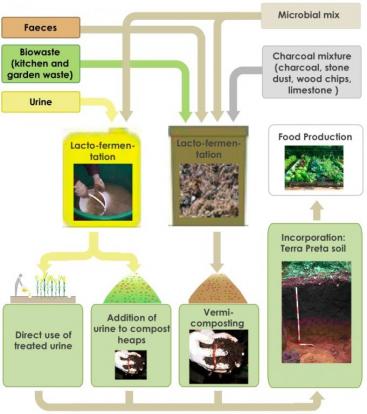CHURN MODE: Les dejo unos curiosos links de los curiosos sistemas de acueductos y alcantarillados desarrollados por los Mayas y que ahora estan siendo redescubiertos para alternativas economicas para el compostaje y reuso de agua.
http://www.sswm.info/category/implementation-tools/wastewater-treatment/hardware/processes/terra-preta-sanitation
Today, this concept has been rediscovered for the treatment of human faeces and household wastes (e.g. kitchen wastes). A promising application of terra preta sanitation (TPS) is the adaption of existing urine diverting toilets to replace the storage and dehydration treatment of urine and faeces. Terra preta sanitation (TPS) systems are based on a three-step process of collection (including urine diversion), lactic acid fermentation and vermicomposting. Lacto-fermentation is an anaerobic process, but in opposition to anaerobic digestion no gases are produced. The process thus is also odour free which makes it particularly interesting for in-house systems even in urban areas. TPS has a high potential to prevent nutrient or carbon loss to the atmosphere by producing highly fertile compost (terra preta) and liquid fertilizer for agriculture.
Treatment Process and Basic Design Principles
The concept of terra preta sanitation. Compiled by SPUHLER, D.; adapted from TILLEY et al. (2008) and GENSCH (2010 b)
Mas detalles en su website.
El principio, sistemas de compostaje creados por los mayas cientos de a/nos antes de la llegada de Colon a America:
Paving paradise to put up a … fountain — or a toilet?
Archaeologists already know that the Maya had an extensive irrigation system, fed by nine streams that ran through Palenque to the fields below.The constricted conduit, one of nine, had a capacity of about 68,000 liters, and it alone could have stored enough water to supply scanty rations for several thousand people for a week during the dry season.
The pressurized pipe could have supplied a fountain where people could dip jars to collect drinking water. But the putative fountain was “probably beautiful,” says co-author Kirk French, a lecturer in anthropology at Penn State. “Everything the Maya did at Palenque was over the top, grandiose, in art and architecture.”
Fountains also serve a social purpose, says French. “They are in a central part of the city, where people can fill jugs and socialize. It’s funny, we refer to ‘water-cooler conversations,’ but it seems this has been going on for a very long time.”
http://www.boingboing.net/2011/05/04/inside-the-ancient-m.html


No comments:
Post a Comment